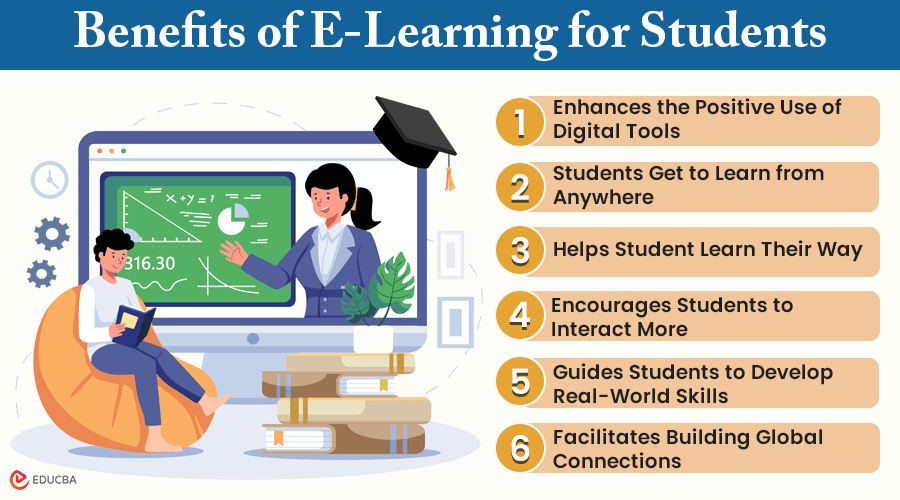Are There Actual Benefits of E-Learning for Students?
Since 2010 and mostly after the pandemic, education has gone beyond the traditional classroom walls. E-learning, or online learning, has become a game-changer, offering students new ways to learn anytime, anywhere. It’s like having a virtual classroom at your fingertips. Understanding the benefits of e-learning for students helps teachers create an inclusive environment. Moreover, it also helps students accelerate professional development.
This article discusses how online education strengthens classroom experiences.
6 Benefits of E-Learning for Students
Following are the benefits of e-learning for students:
#1. Enhances the Positive Use of Digital Tools
Going digital with learning makes sense. Kids are already using computers, phones, and tablets all the time. E-learning transforms traditional lectures and textbooks into engaging online content like videos, games, blogs, and apps. This approach allows teachers to create lessons that match how students prefer to learn today; it helps to capture their attention and motivate them to participate actively.
#2. Students Get to Learn from Anywhere
E-learning removes the limitations of the classroom. Students can access online lessons from anywhere with an internet connection—at home, in the library, or while traveling. There’s no need to pause learning due to location, weather, or other circumstances. E-learning fills these gaps and ensures children can continue their educational journey without interruption.
#3. Helps Student Learn Their Way
One size doesn’t fit all is also true when it comes to learning. E-learning is a tool that can adapt to each student’s unique abilities and interests. The most effective learning occurs when students can progress at their own speed and follow their own learning path, and e-learning facilitates this. It allows students to revisit the material as often as they need, providing a flexible learning environment. For those keen on specific topics, e-learning offers the opportunity to delve deeper.
#4. Encourages Students to Interact More
E-learning encourages students to interact more. They can connect with peers and teachers in new ways, like chatting online, working together on projects, and sharing feedback. It helps them learn to cooperate and appreciate different viewpoints. For shy kids, e-learning provides a safe space to open up and find their voice.
#5. Guides Students to Develop Real-World Skills
E-learning helps students develop real-world skills by offering interactive lessons and practical exercises that simulate real-life situations. Online platforms allow students to engage with multimedia content, collaborate with peers, and receive instant instructor feedback. This interactive approach promotes critical thinking, problem-solving, and communication skills. Additionally, e-learning allows students to learn independently, accommodating different learning styles and preferences.
#6. Facilitates Building Global Connections
Digital classrooms enable students to interact online with peers from different states or countries. Imagine how chatting with a student from Mexico could enhance a Spanish class. Video conferences make connecting with real scientists, authors, or historical experts possible. Field trips can now be virtual tours of museums worldwide. The possibilities are endless when learning is globally connected.
E-Learning Tips for Parents
- Set up a quiet, distraction-free area for your child to focus on their online learning.
- Establish rules to keep your child safe online and help them avoid inappropriate content.
- Remind your teen to communicate respectfully and appropriately in their online classes.
- Regularly ask your child about what they are learning online so that you are aware of your child’s academic journey.
- Praise your child when they use online education tools independently. It boosts student’s confidence and motivates them to continue learning digitally.
- If technical problems arise, reassure your child that it’s okay, and they can try again later.
E-Learning Tips for Educators
- Involve students in choosing e-learning activities and projects to boost their engagement. Their input is important.
- Encourage students to work together on online assignments to build teamwork skills.
- Record short video tutorials to help students with online platforms and tech tools.
- Understand that technical problems can happen. Encourage perseverance and problem-solving skills.
- Keep a close eye on student progress to identify any gaps early. Provide extra support when needed.
- Show examples of excellent past e-learning assignments to give students a model to follow.
Final Thoughts
The benefits of e-learning for students are abundant. It offers students exciting benefits. By combining digital learning with traditional methods, students can engage deeply with their studies and prepare for the real world. It aligns with their digital preferences, making learning more enjoyable and personalized. With e-learning, the future of education looks bright, and there are endless opportunities for students to excel.
Recommended Articles
We hope the article on the benefits of e-learning for students was informative and helpful. To learn more, refer to the below articles.



